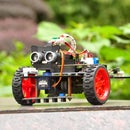Introduction: OSOYOO NodeMCU Development Board, Your Gateway to IoT
Step into the world of IoT with the OSOYOO NodeMCU development board. This powerful board, based on the ESP8266, offers WiFi connectivity, a built-in USB to UART converter, and an array of keys for interactive programming. Whether you're a seasoned developer or just starting, this board opens doors to endless possibilities.
Supplies
Features That Matter
- Open-source: Join a thriving community of developers, making innovation accessible.
- Arduino-like hardware: Familiarity meets IoT with a hardware setup reminiscent of Arduino.
- WI-FI enabled: Seamlessly connect to the internet and the IoT ecosystem.
- Status LED: Visual feedback for your projects.
- Type C USB port: Modern and versatile USB connectivity.
- Reset/Flash buttons: Easy control for your projects.
- Interactive and Programmable: Your imagination is the limit.
- Low cost: Affordable access to advanced IoT development.
- USB to UART converter: Simplified communication with your computer.
- GPIO pins: A plethora of pins for your peripherals.
Specifications at a Glance
- WIFI module: ESP-12F
- Processor: ESP8266
- Built-in Flash Memory/SRAM: 4 MB / 64 KB
- Clock Speed: 80 MHz
- USB to Serial convert chip: CH340C
- USB – Type C port: Power, programming, and debugging at your fingertips.
- Antenna: Onboard PCB antenna
- Peripheral interface: UART/SPI/I2C/SDIO/GPIO/ADC/PWM
- WiFi protocol: IEEE 802.11 b/g/n
- Frequency range: 2.4G ~ 2.5G (2400M ~ 2483.5M)
- Serial port baud rate configuration: 1200/2400/4800/9600/19200/38400/57600/74800/115200 bps
- WiFi operation current: Continuous transmission operation: ≈70mA (200mA MAX), deep sleep mode: <3mA
- Serial WiFi transmission rate: 110-460800bps
- WiFi mode: Station / SoftAP / SoftAP+Station
- Power supply: 5V
- Logic level: 3.3V
- Input Voltage: 4.5-18V
- Dimensions: 52mm x 26mm
Step 1: Getting Started With Your NodeMCU: a Quick Guide
Welcome to the world of NodeMCU! Here's a step-by-step guide to get you started with this powerful development board.
1.Connect Your NodeMCU to the Computer:
Using a USB cable, connect your NodeMCU to your computer. You'll notice the blue onboard LED flickering when powered up, but it won't stay lit.
2.Install the COM/Serial port driver
In order to upload code to the ESP8266 and use the serial console, connect any data-capable micro USB cable to ESP8266 IOT Board and the other side to your computer’s USB port.
The NodeMCUv0.9 comes with the CH340 serial chip,you can download and install the driver here.
3.Install the Arduino IDE 1.6.4 or greater
Download IDE from Arduino.cc (1.6.4 or greater) . You can use your existing IDE if you have already installed it.
You can also try downloading the ready-to-go package from the ESP8266-project, if the proxy is giving you problems
Step 2: Install the COM/Serial Port Driver
In order to upload code to the ESP8266 and use the serial console, connect any data-capable micro USB cable to ESP8266 IOT Board and the other side to your computer’s USB port.
The NodeMCUv0.9 comes with the CH340 serial chip,you can download and install the driver here.
Step 3: Install the Arduino IDE 1.6.4 or Greater
Download the Arduino IDE from Arduino.cc (version 1.6.4 or later). If you already have it installed, you can use your existing IDE.
You can also try downloading the ready-to-go package from the ESP8266-project if you encounter proxy issues.
Step 4: Install the ESP8266 Board Package
Step 1: Enter http://arduino.esp8266.com/stable/package_esp8266com_index.json into the "Additional Board Manager URLs" field in the Arduino v1.6.4+ preferences (Open Arduino IDE –> File –> Preferences –> Settings).

Enter the link and click "OK" to save your changes.
Step 2: SELECT CORRESPONDING SERIAL PORT

It's crucial to select the correct Serial port. Fortunately, if you have a board compatible with Arduino UNO, the name will appear next to the serial port menu item, making it easy to choose!
Step 3: Use the Board Manager to install the ESP8266 package

Enter the Boards Manager and find the board type as below:
Scroll the Boards Manager screen down to the bottom; you will see a module called "esp8266 by esp8266 Community" (see the following picture). Select the latest version and click "Install."

The ESP8266 package has been installed successfully. Note: You'd better close the Arduino IDE and restart it again.
Step 4: Setup ESP8266 Support
Select "OSOYOO NodeMCU" from the Tools->Board dropdown->ESP8266 Boards(3.1.1)->NodeMCU1.0(ESP-12E Module)

Select Debug port from Tools->Debug port:Serial Configure the Board menu and choose the right Port for your device.
- CPU Frequency: 80MHz,
- Flash Size: 4M (FS: 2MB OTA: ~1019KB),
- Upload Speed: 115200


Step 5: Start Coding
Now you're ready to start coding! Let's use an example that comes with the IDE to see how it works. Navigate to File->Examples->ESP8266 WiFi->WiFiScan.

You will see the sketch windows, click "√" or "->" to Verify/Compile it.

After a few seconds, you should see the message "Done uploading." Then click the Serial Monitor button.

Make sure the serial monitor's COM port corresponds to your port, and check if the serial monitor Baudrate matches your sketch setting. If yes, you will see serial output displaying information like the IP address.

Note: 115200 baud upload speed is a good place to start. You can try higher speeds later, but 115200 is a safe starting point.
If you've completed all these steps and your program is running successfully, congratulations! You're up and running with NodeMCU. If you encounter any problems, please refer to the troubleshooting suggestions on Arduino's official website.










![Tim's Mechanical Spider Leg [LU9685-20CU]](https://content.instructables.com/FFB/5R4I/LVKZ6G6R/FFB5R4ILVKZ6G6R.png?auto=webp&crop=1.2%3A1&frame=1&width=306)


